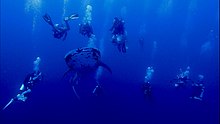| Legal status | nonprofit |
|---|---|
| Purpose | Online citizen science database to identify and track sharks, in particular whale sharks |
| Parent organization | Marine Megafauna Foundation, WildMe |
| Volunteers | 9445 citizen scientists, 313 researchers |
| Website | https://www.sharkbook.ai |
| Formerly called | whaleshark.org, wildbook for whale sharks |
Sharkbook is a global database for identifying and tracking sharks, particularly whale sharks, using uploaded photos and videos.In addition to identifying and tracking sharks, the site allows people to "adopt a shark" and get updates on specific animals.
Creation
Sharkbook is the result of collaboration between Simon J Pierce of the Marine Megafauna Foundation and Jason Holmberg of Wild Me. The software is Open Source and is now being used by other biology projects.

Identification of individual sharks
Whale sharks have unique spot patterning on their sides, similar to a human fingerprint, which allows for individual identification. Scuba divers around the world can photograph sharks and upload their identification photographs to the Sharkbook website, supporting global research and conservation efforts. Additionally, the software automatically searches social media sites like YouTube and Instagram to look for images of whale sharks and adds them to the database.
Sharkbook software uses special pattern-matching software to identify the unique spots on each shark. This software and algorithms were originally adapted from NASA star tracking software used on the Hubble Space Telescope. This software uses a scale-invariant feature transform (SIFT) algorithm, which can cope with complications presented by highly variable spot patterns and low contrast photographs.
Purpose
This citizen science tool is free to use by researchers worldwide. Sharkbook represents a global initiative to centralize shark sightings and facilitate research on these vulnerable species.
See also
- Manta Matcher - For Manta Rays
- Flukebook - For whales and dolphins
References
- Davis, Jessica (2021-06-29). "How a Wildlife AI Platform Solved its Data Challenge". InformationWeek. Retrieved 28 December 2024.
- ^ "How A.I. is helping to protect the endangered whale sharks of the Galapagos". Fortune. Retrieved 2023-02-09.
- ^ "How artificial intelligence is changing wildlife research". National Geographic. 2018-11-13. Archived from the original on February 23, 2021. Retrieved 2023-02-10.
- ^ Marshall, A. D.; Pierce, S. J. (April 2012). "The use and abuse of photographic identification in sharks and rays". Journal of Fish Biology. 80 (5): 1361–1379. doi:10.1111/j.1095-8649.2012.03244.x. PMID 22497388.
- Weintraub, Karen (2017-11-29). "Tracking the Elusive Whale Shark". The New York Times. ISSN 0362-4331. Retrieved 2023-02-10.
- "Tracking the Sea's Gentle Giants". National Geographic. 2016-11-11. Archived from the original on May 28, 2022. Retrieved 2023-02-10.
- "Nature up close: Whale sharks". CBS News. 21 October 2016. Retrieved 2023-02-10.
- McCoy, Emer; Burce, Raul; David, David; Aca, Elson Q.; Hardy, Jennifer; Labaja, Jessica; Snow, Sally J.; Ponzo, Alessandro; Araujo, Gonzalo (2018). "Long-Term Photo-Identification Reveals the Population Dynamics and Strong Site Fidelity of Adult Whale Sharks to the Coastal Waters of Donsol, Philippines". Frontiers in Marine Science. 5. doi:10.3389/fmars.2018.00271. ISSN 2296-7745.
- "🔭 The Hubble Telescope could help save the world's largest fish". Warp News. 2021-03-01. Retrieved 2023-02-12.
- "Scientists are using cloud computing and AI to track these mysterious, beautiful whale sharks". ZDNET. Retrieved 2023-02-10.
- Russell, Mark 'Crowley' (2022-03-21). "Study shows need for whale shark population monitoring". DIVE Magazine. Retrieved 2023-02-10.
- Stacey, Adrian (2020-05-20). "Dive Photos Needed | Scuba Diver Mag". Retrieved 2023-02-09.
- "Whale shark sightings increase in Tampa Bay area (w/video)". Tampa Bay Times. Retrieved 2023-02-10.
- "22 years and counting – the two whale sharks calling Ningaloo home". Australian Geographic. 2016-10-12. Retrieved 2023-02-10.
- Araujo, Gonzalo; Agustines, Ariana; Tracey, Brian; Snow, Sally; Labaja, Jessica; Ponzo, Alessandro (2019-11-20). "Photo-ID and telemetry highlight a global whale shark hotspot in Palawan, Philippines". Nature. 9 (1): 17209. Bibcode:2019NatSR...917209A. doi:10.1038/s41598-019-53718-w. ISSN 2045-2322. PMC 6868279. PMID 31748588.